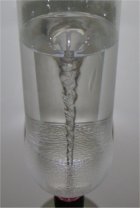
Two bottles have been joined and one of them is full of water. If we turn them upside-down and then twist the top one with a movement similar to mixing pastry, we create our own twister.
JW Player goes here
|
The vortices that are formed as a result revolve either left or right depending on the way we twist. In this way we can bring about our own twister in a bottle. In general, vortices form when the speed of flow changes dramatically and the phenomenon of viscosity is of great importance. In the vortex created in the bottle the speed of the water near the sides is approximately zero, while the closer to the centre, the greater the speed of the water.
Convection currents are good example of vortices. They form in atmosphere on nice spring and summer days. The air in such currents travels in spirals and has the shape of a vortex. But as it get higher, this 'column' of rising air widens (as a result of adiabatic expansion), and cold air that surrounds this ascending current is the element that has something to do with viscosity. If the air gathers enough momentum a twister is formed.
more